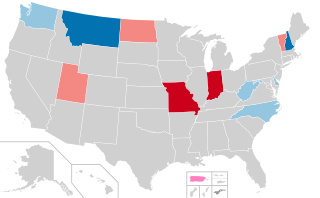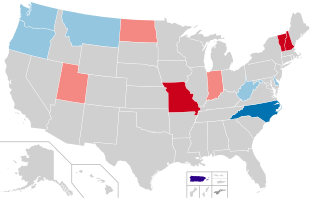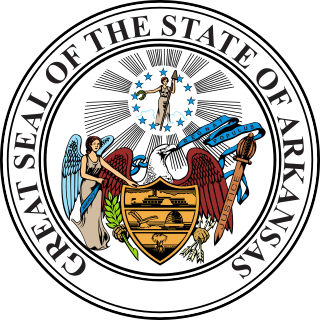
The 2004 North Carolina gubernatorial election was held on November 2, 2004. The general election was between the Democratic incumbent Mike Easley and the Republican nominee Patrick J. Ballantine. Easley won by 56% to 43%, winning his second term as governor. This is the last time a Democrat was elected governor of North Carolina by double digits.

United States gubernatorial elections were held on November 2, 2004, in 11 states and two territories. There was no net gain in seats for either party, as Democrats picked up an open seat in Montana while defeating incumbent Craig Benson in New Hampshire, while Republicans defeated incumbent Joe Kernan in Indiana and won Missouri after Bob Holden lost in the primary. These elections coincided with the presidential election.

The 2008 North Carolina gubernatorial election was held on November 4, 2008, coinciding with the presidential, U.S. Senate, U.S. House elections, Council of State and statewide judicial elections. Democrat Bev Perdue won the election. With a margin of 3.39%, this election was the closest race of the 2008 gubernatorial election cycle.

United States gubernatorial elections were held on November 5, 2002, in 36 states and two territories. The Republicans won eight seats previously held by the Democrats, as well as the seat previously held by Minnesota governor Jesse Ventura, who was elected on the Reform Party ticket but had since renounced his party affiliation. The Democrats won 10 seats previously held by the Republicans, as well as the seat previously held by Maine governor Angus King, an independent. The elections were held concurrently with the other United States elections of 2002.

United States gubernatorial elections were held on November 7, 2000, in 11 states and two territories. The elections coincided with the presidential election. Democrats gained one seat by defeating an incumbent in West Virginia. As of 2024, this remains the last gubernatorial cycle in which a Democrat won in Indiana.

The 2012 North Carolina gubernatorial election took place on November 6, 2012, concurrently with the 2012 United States presidential election, U.S. House election, statewide judicial election, Council of State election and various local elections.

United States gubernatorial elections were held in 12 states and two territories. Of the eight Democratic and four Republican seats contested, only that of North Carolina changed party hands, giving the Republicans a net gain of one governorship. These elections coincided with the presidential election on November 6, 2012. As of 2024, this marked the last time in which a Democrat won the governorship in Missouri and the last time in which a Republican won the governorship in North Carolina.

The 2008 North Carolina lieutenant gubernatorial election was held on November 4, 2008, as part of the elections to the Council of State. North Carolina also held a gubernatorial election on the same day, but the offices of governor and lieutenant governor are elected independently.

The 1992 North Carolina gubernatorial election was held on November 3, 1992. Incumbent Governor James G. Martin was unable to run for a third consecutive term due to term limits, and his Lieutenant Governor, Jim Gardner, was chosen to replace him as the Republican nominee. Gardner had also been the nominee in a previous gubernatorial election over twenty years earlier. Former Governor Jim Hunt decided to seek his third term as the Democratic nominee. The race became one of the nastiest and most talked about races in the country, with Hunt winning a third term easily over Gardner and Libertarian nominee Scott McLaughlin.

The 1984 North Carolina gubernatorial election was held on November 6, 1984. Democratic incumbent Jim Hunt was unable to run for another consecutive term under the North Carolina Constitution. Hunt ran instead for the U.S. Senate against Jesse Helms and lost, although he later announced his campaign for a third gubernatorial term in the 1992 election. Popular 9th District Congressman James G. Martin ran as the Republican nominee against Democratic Attorney General Rufus L. Edmisten, who defeated Hunt's Lt. Governor, James Green, among other candidates, in a hotly contested primary.

The North Carolina Council of State elections of 2012 were held November 6, 2012 to select the nine officers of the North Carolina Council of State. This election coincided with the U.S. presidential election, U.S. House elections, the gubernatorial election and the statewide judicial elections. Primary elections were held on May 8, 2012; for races in which no candidate received 40 percent of the vote in the primary, runoff elections were held on July 17.

United States gubernatorial elections were held on November 8, 2016, in 12 states and two territories. The last regular gubernatorial elections for nine of the 12 states took place in 2012. The last gubernatorial elections for New Hampshire, Oregon, and Vermont took place in 2014, as Oregon held a special election due to the resignation of Governor John Kitzhaber, while the governors of New Hampshire and Vermont both serve two-year terms. The 2016 gubernatorial elections took place concurrently with several other federal, state, and local elections, including the presidential election, Senate, and House elections.

The 1988 United States presidential election in South Carolina took place on November 8, 1988. All 50 states and the District of Columbia, were part of the 1988 United States presidential election. South Carolina voters chose eight electors to the Electoral College, which selected the president and vice president.

The 2016 North Dakota gubernatorial election was held on November 8, 2016, to elect the Governor and Lieutenant Governor of North Dakota, concurrently with the 2016 U.S. presidential election, as well as elections to the United States Senate, elections to the United States House of Representatives and various state and local elections. This would have been the first time North Dakotans selected a governor under new voter ID requirements, in which a student ID was insufficient identification to vote, but a court ruling in August 2016 struck the down the provision; the election was held under the 2013 rules.

The 2020 North Carolina gubernatorial election was held on November 3, 2020, to elect the Governor of North Carolina, concurrently with the 2020 U.S. presidential election, as well as elections to one-third of the United States Senate and elections to the United States House of Representatives and various state and local elections. Incumbent Democratic Governor Roy Cooper was eligible to run for re-election to a second term in office, and announced his intention to do so on December 5, 2019.

United States gubernatorial elections were held on November 8, 2022, in 36 states and three territories. As most governors serve four-year terms, the last regular gubernatorial elections for all but two of the seats took place in the 2018 U.S. gubernatorial elections. The gubernatorial elections took place concurrently with several other federal, state, and local elections, as part of the 2022 midterm elections.

The 1942 Arkansas gubernatorial election was held on November 3, 1942. Incumbent Democratic Governor Homer Martin Adkins was re-elected to a second term in office.

The 1891 Massachusetts gubernatorial election was held on November 3, 1891. Incumbent Democratic Governor William Russell was re-elected to a second term in office over Republican U.S. Representative Charles H. Allen.

The 1932 Maine gubernatorial election took place on September 12, 1932. Incumbent Republican Governor William Tudor Gardiner did not seek re-election. Democratic candidate Louis J. Brann defeated Republican candidate Burleigh Martin. Brann was the first Democrat elected Governor of Maine since Oakley C. Curtis in 1914.

United States gubernatorial elections are scheduled to be held on November 5, 2024, in 11 states and two territories. The previous gubernatorial elections for this group of states took place in 2020, except in New Hampshire and Vermont where governors only serve two-year terms and elected their governors in 2022. In addition to state gubernatorial elections, the territories of American Samoa and Puerto Rico will also hold elections for their governors.
















